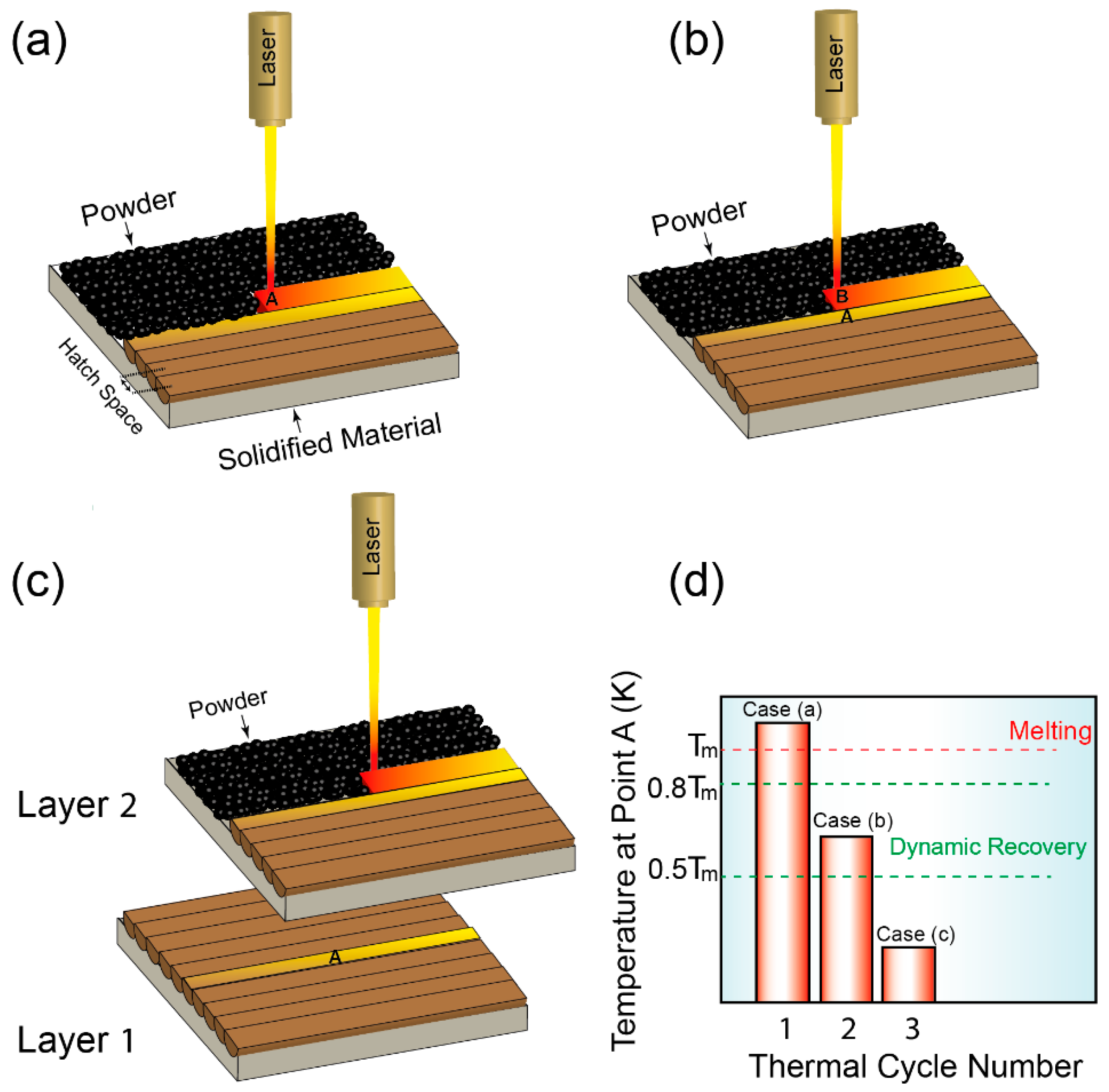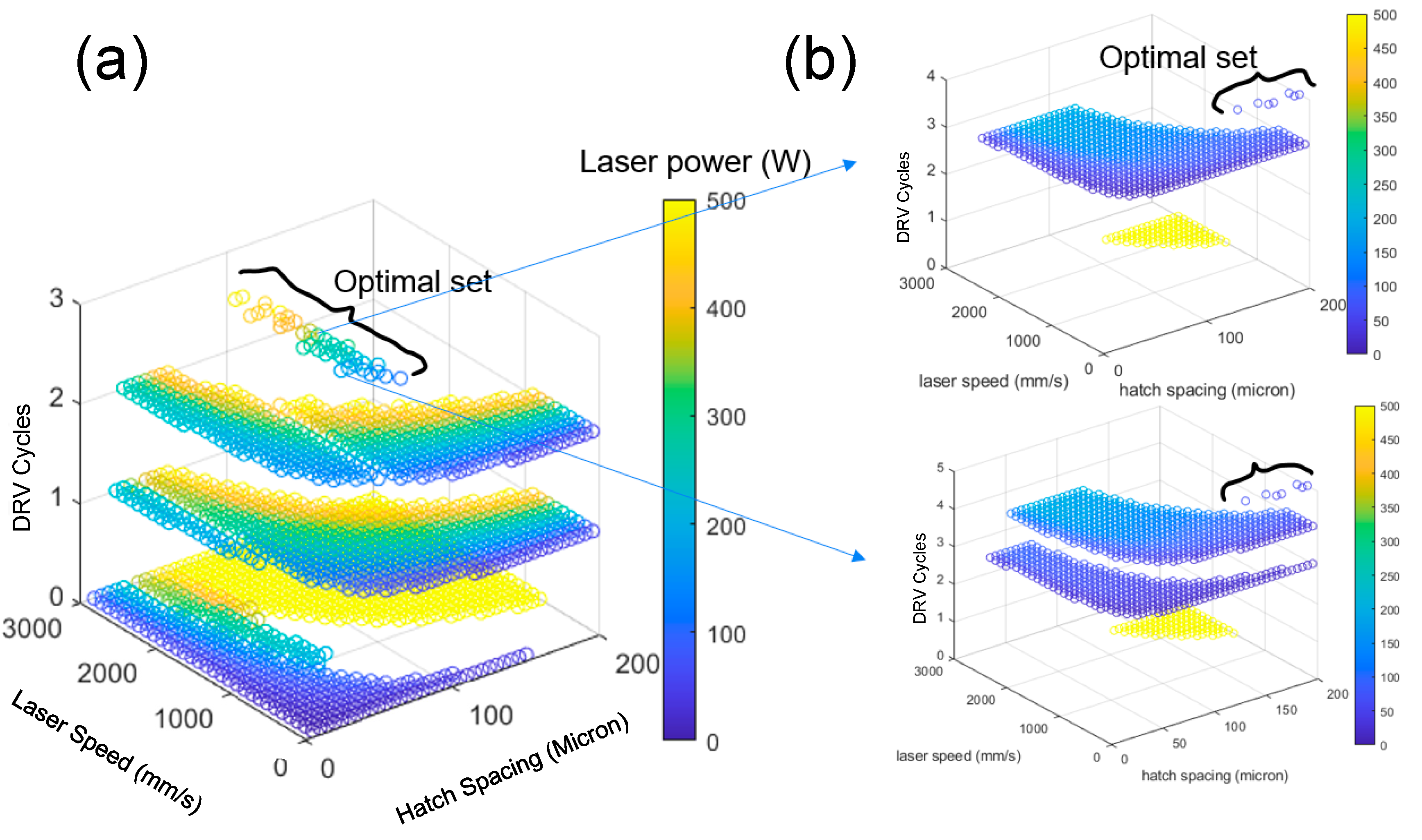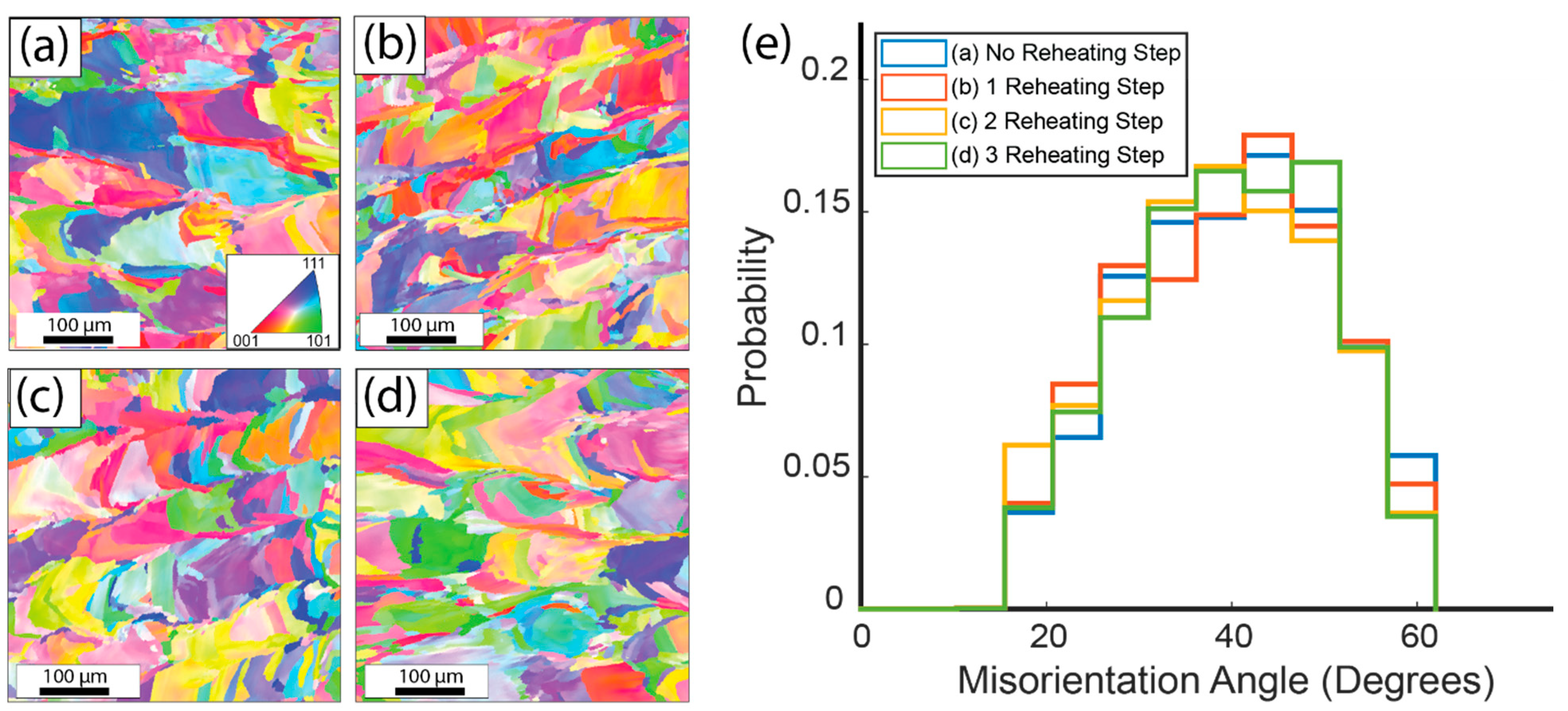Novel Approach to Grain Boundary Modification in Stainless and Duplex Steel L-PBF Components through In Situ Heat Treatment
Abstract
:1. Introduction
2. Materials and Method
2.1. Experimental Approach
- ■
- Materials: In this study, 2507 super duplex steel and 316L austenitic stainless-steel powders, provided by GKN Additive Inc. (Carlsbad, CA, USA), were used for the laser powder bed fusion (L-PBF) process. The powders were spherical in shape and produced using a gas atomization method, ensuring a narrow size distribution and low levels of impurities. The average particle size of the powder was 50 microns, which is considered suitable for the L-PBF process. The components were fabricated using the PANDA L-PBF machine from Open Additive (Beavercreek, OH, USA, equipped with a 500 W IPG Photonics 1070 nm fiber laser (air cooled)).
- ■
- Reheat scan technique: To manage thermal cycling in the L-PBF process, a reheat scan step was implemented after each melting step in the experimental setup. This additional laser scan raised the temperature of the solidified material to a level slightly below its melting point. By adjusting parameters such as the laser power and scan speed, we were able to modify the microstructure and grain boundary properties of the fabricated samples. In the following section, we provide detailed information on the specific parameters used and their influence on the microstructure.
- ■
- Microstructure Analysis: Microstructure analysis was conducted using a Tescan Mira (California, CA, USA) scanning electron microscope (SEM) that was equipped with an Electron Backscatter Diffraction (EBSD) EDAX camera. The SEM was operated at a voltage of 30 kV, a current of 20 nA, and a step size of 1 micron. Prior to EBSD analysis, the samples were prepared by grinding them with 600–1200 grit SiC sandpaper, followed by polishing using 1 μm of diamond suspension and 0.04 μm of colloidal silica.
2.2. Thermal Model
2.3. Results and Discussion
- (a)
- Optimization of both the melting and the reheating scans to maximize dynamic recovery.
- (b)
- Utilizing predefined process parameters for the melting scan, selected based on density analysis, followed by the optimization of the reheating scan.
3. Conclusions
Author Contributions
Funding
Conflicts of Interest
References
- Gao, W.; Zhang, Y.; Ramanujan, D.; Ramani, K.; Chen, Y.; Williams, C.B.; Wang, C.C.; Shin, Y.C.; Zhang, S.; Zavattieri, P.D. The status, challenges, and future of additive manufacturing in engineering. Comput.-Aided Des. 2015, 69, 65–89. [Google Scholar] [CrossRef]
- Huang, Y.; Leu, M.C.; Mazumder, J.; Donmez, A. Additive manufacturing: Current state, future potential, gaps and needs, and recommendations. J. Manuf. Sci. Eng. 2015, 137, 014001. [Google Scholar] [CrossRef]
- Frazier, W.E. Metal additive manufacturing: A review. J. Mater. Eng. Perform. 2014, 23, 1917–1928. [Google Scholar] [CrossRef]
- Kotadia, H.; Gibbons, G.; Das, A.; Howes, P. A review of Laser Powder Bed Fusion Additive Manufacturing of aluminium alloys: Microstructure and properties. Addit. Manuf. 2021, 46, 102155. [Google Scholar] [CrossRef]
- Kusoglu, I.M.; Gökce, B.; Barcikowski, S. Research trends in laser powder bed fusion of Al alloys within the last decade. Addit. Manuf. 2020, 36, 101489. [Google Scholar] [CrossRef]
- Sing, S.L.; Yeong, W.Y. Laser powder bed fusion for metal additive manufacturing: Perspectives on recent developments. Virtual Phys. Prototyp. 2020, 15, 359–370. [Google Scholar] [CrossRef]
- Hirth, J.P. The Influence of Grain Boundaries on Mechanical Properties; Springer: Berlin/Heidelberg, Germany, 1972. [Google Scholar]
- Kacher, J.; Eftink, B.; Cui, B.; Robertson, I. Dislocation interactions with grain boundaries. Curr. Opin. Solid State Mater. Sci. 2014, 18, 227–243. [Google Scholar] [CrossRef]
- Thapliyal, S.; Agrawal, P.; Agrawal, P.; Nene, S.S.; Mishra, R.S.; McWilliams, B.A.; Cho, K.C. Segregation engineering of grain boundaries of a metastable Fe-Mn-Co-Cr-Si high entropy alloy with laser-powder bed fusion additive manufacturing. Acta Mater. 2021, 219, 117271. [Google Scholar] [CrossRef]
- Sabzi, H.E.; Hernandez-Nava, E.; Li, X.-H.; Fu, H.; San-Martín, D.; Rivera-Díaz-del-Castillo, P.E. Strengthening control in laser powder bed fusion of austenitic stainless steels via grain boundary engineering. Mater. Des. 2021, 212, 110246. [Google Scholar] [CrossRef]
- Li, J.; Qu, H.; Bai, J. Grain boundary engineering during the laser powder bed fusion of TiC/316L stainless steel composites: New mechanism for forming TiC-induced special grain boundaries. Acta Mater. 2022, 226, 117605. [Google Scholar] [CrossRef]
- Abdi, F.; Eftekharian, A.; Huang, D.; Rebak, R.B.; Rahmane, M.; Sundararaghavan, V.; Kanyuck, A.; Gupta, S.K.; Arul, S.; Jain, V. Grain boundary engineering of new additive manufactured polycrystalline alloys. Forces Mech. 2021, 4, 100033. [Google Scholar] [CrossRef]
- Rezayat, M.; Karamimoghadam, M.; Moradi, M.; Casalino, G.; Roa Rovira, J.J.; Mateo, A. Overview of Surface Modification Strategies for Improving the Properties of Metastable Austenitic Stainless Steels. Metals 2023, 13, 1268. [Google Scholar] [CrossRef]
- Fayazfar, H.; Salarian, M.; Rogalsky, A.; Sarker, D.; Russo, P.; Paserin, V.; Toyserkani, E. A critical review of powder-based additive manufacturing of ferrous alloys: Process parameters, microstructure and mechanical properties. Mater. Des. 2018, 144, 98–128. [Google Scholar] [CrossRef]
- Gatsos, T.; Elsayed, K.A.; Zhai, Y.; Lados, D.A. Review on computational modeling of process–microstructure–property relationships in metal additive manufacturing. Jom 2020, 72, 403–419. [Google Scholar] [CrossRef]
- Lesyk, D.; Martinez, S.; Mordyuk, B.; Pedash, O.; Dzhemelinskyi, V.; Lamikiz, A. Ultrasonic surface post-processing of hot isostatic pressed and heat treated superalloy parts manufactured by laser powder bed fusion. Addit. Manuf. Lett. 2022, 3, 100063. [Google Scholar] [CrossRef]
- Ardi, D.T.; Guowei, L.; Maharjan, N.; Mutiargo, B.; Leng, S.H.; Srinivasan, R. Effects of post-processing route on fatigue performance of laser powder bed fusion Inconel 718. Addit. Manuf. 2020, 36, 101442. [Google Scholar] [CrossRef]
- Sripada, J.; Tian, Y.; Chadha, K.; Saha, G.; Jahazi, M.; Spray, J.; Aranas Jr, C. Effect of hot isostatic pressing on microstructural and micromechanical properties of additively manufactured 17–4PH steel. Mater. Charact. 2022, 192, 112174. [Google Scholar] [CrossRef]
- Peng, X.; Kong, L.; Fuh, J.Y.H.; Wang, H. A review of post-processing technologies in additive manufacturing. J. Manuf. Mater. Process. 2021, 5, 38. [Google Scholar] [CrossRef]
- Kumbhar, N.N.; Mulay, A. Post processing methods used to improve surface finish of products which are manufactured by additive manufacturing technologies: A review. J. Inst. Eng. Ser. C 2018, 99, 481–487. [Google Scholar] [CrossRef]
- Bertoli, U.S.; MacDonald, B.E.; Schoenung, J.M. Stability of cellular microstructure in laser powder bed fusion of 316L stainless steel. Mater. Sci. Eng. A 2019, 739, 109–117. [Google Scholar] [CrossRef]




| Melting Scan Parameter Set | Power (Watt) | Speed (mm/s) | Hatch Space (μm) | Energy | Reheating Scan Parameter Set | Power (Watt) | Speed(mm/s) | Hatch Space (μm) | Energy |
|---|---|---|---|---|---|---|---|---|---|
| 1 | 128 | 500 | 80 | 80 | 1 | 70 | 300 | 195 | 30 |
| 2 | 230 | 900 | 80 | 80 | 2 | 56 | 200 | 200 | 35 |
| 3 | 358 | 1400 | 80 | 80 | 3 | 30 | 1500 | 25 | 20 |
| 4 | 170 | 800 | 65 | 82 | 4 | 56 | 200 | 200 | 35 |
| 5 | 300 | 1400 | 80 | 67 | 5 | 54 | 200 | 175 | 40 |
| Reheating Scan Parameter Set | Power (Watt) | Speed (mm/s) | Hatch Space (μm) | Energy |
|---|---|---|---|---|
| 1 | 24 | 1000 | 30 | 20 |
| 2 | 48 | 2000 | 30 | 20 |
| 3 | 26 | 1100 | 20 | 30 |
| 4 | 43 | 1800 | 20 | 30 |
Disclaimer/Publisher’s Note: The statements, opinions and data contained in all publications are solely those of the individual author(s) and contributor(s) and not of MDPI and/or the editor(s). MDPI and/or the editor(s) disclaim responsibility for any injury to people or property resulting from any ideas, methods, instructions or products referred to in the content. |
© 2023 by the authors. Licensee MDPI, Basel, Switzerland. This article is an open access article distributed under the terms and conditions of the Creative Commons Attribution (CC BY) license (https://creativecommons.org/licenses/by/4.0/).
Share and Cite
Andani, M.T.; Sundararaghavan, V.; Misra, A. Novel Approach to Grain Boundary Modification in Stainless and Duplex Steel L-PBF Components through In Situ Heat Treatment. Crystals 2023, 13, 1314. https://doi.org/10.3390/cryst13091314
Andani MT, Sundararaghavan V, Misra A. Novel Approach to Grain Boundary Modification in Stainless and Duplex Steel L-PBF Components through In Situ Heat Treatment. Crystals. 2023; 13(9):1314. https://doi.org/10.3390/cryst13091314
Chicago/Turabian StyleAndani, Mohsen Taheri, Veera Sundararaghavan, and Amit Misra. 2023. "Novel Approach to Grain Boundary Modification in Stainless and Duplex Steel L-PBF Components through In Situ Heat Treatment" Crystals 13, no. 9: 1314. https://doi.org/10.3390/cryst13091314
APA StyleAndani, M. T., Sundararaghavan, V., & Misra, A. (2023). Novel Approach to Grain Boundary Modification in Stainless and Duplex Steel L-PBF Components through In Situ Heat Treatment. Crystals, 13(9), 1314. https://doi.org/10.3390/cryst13091314







